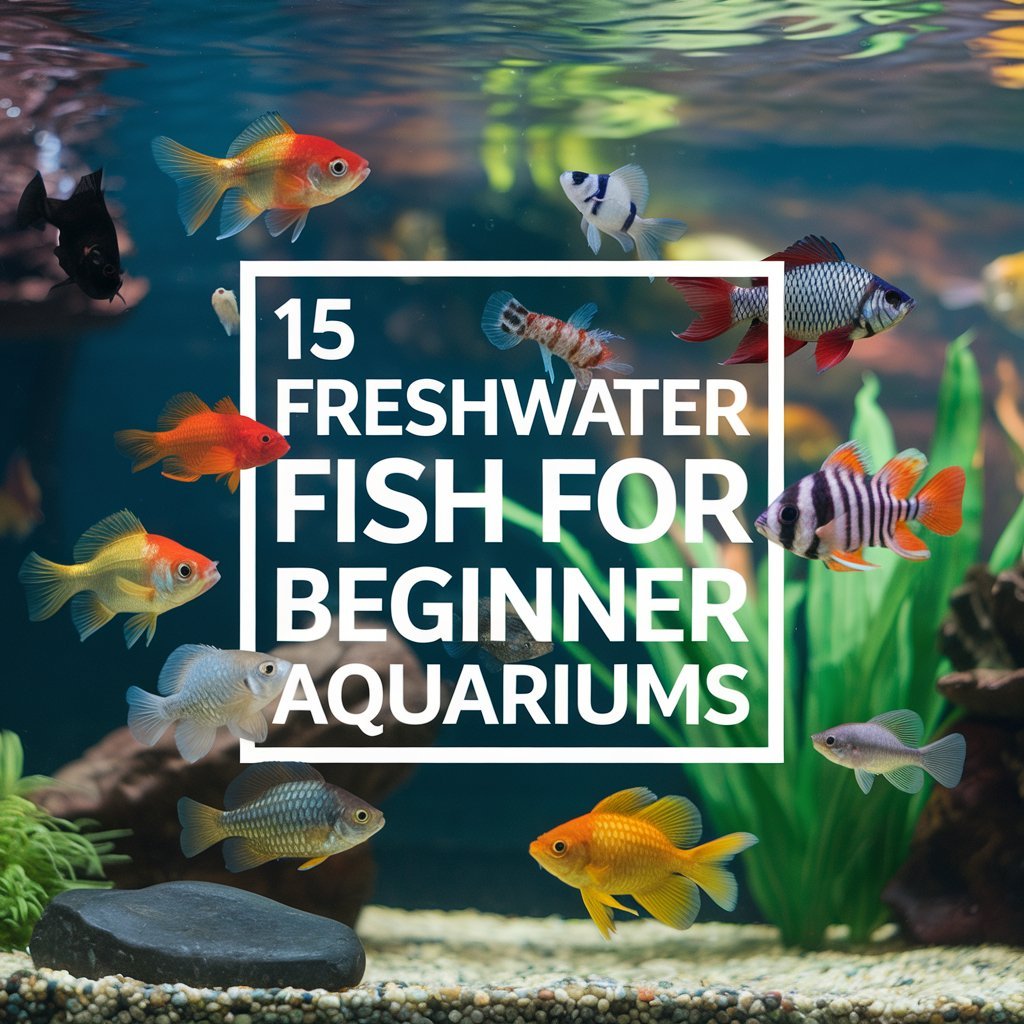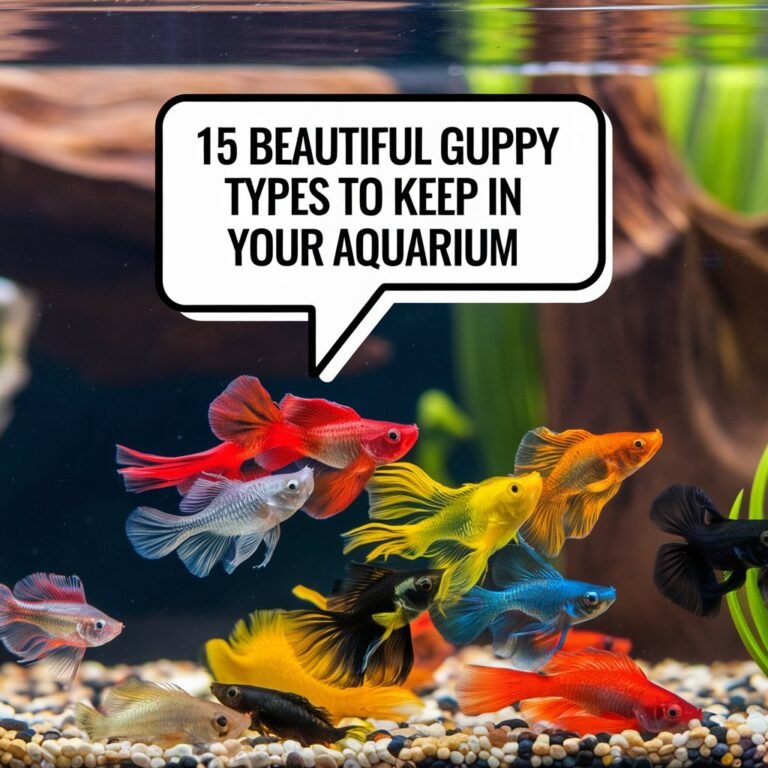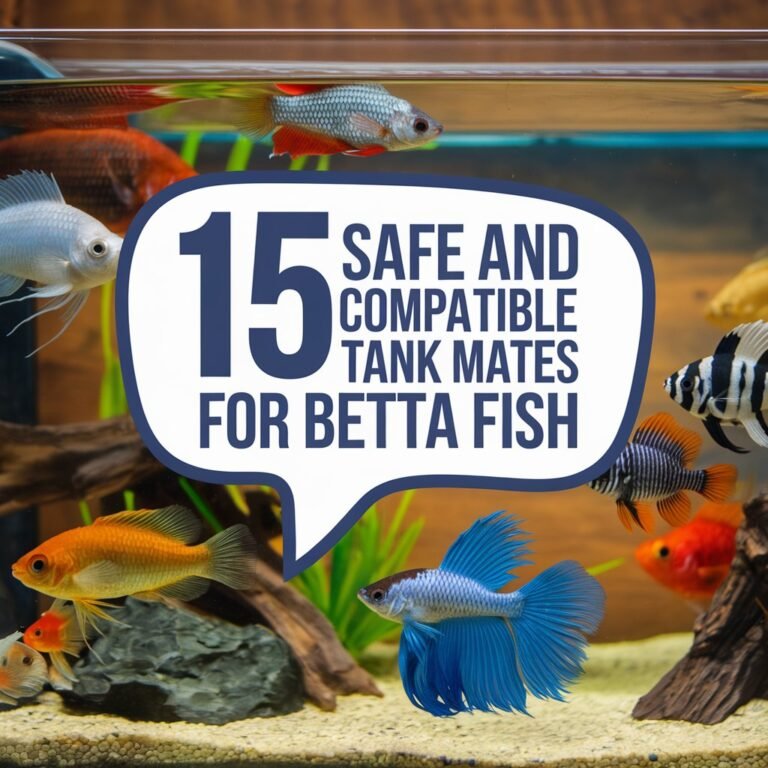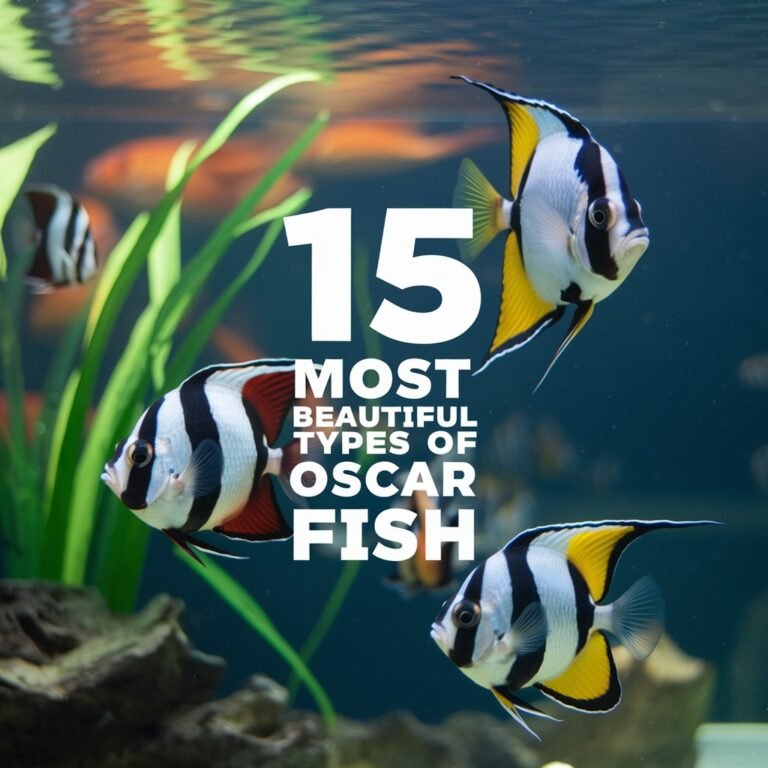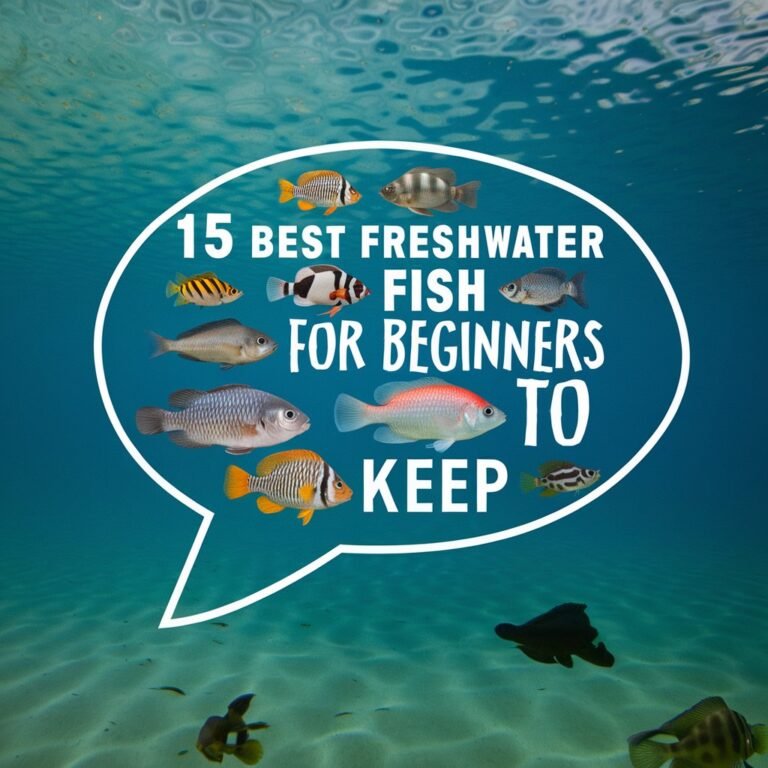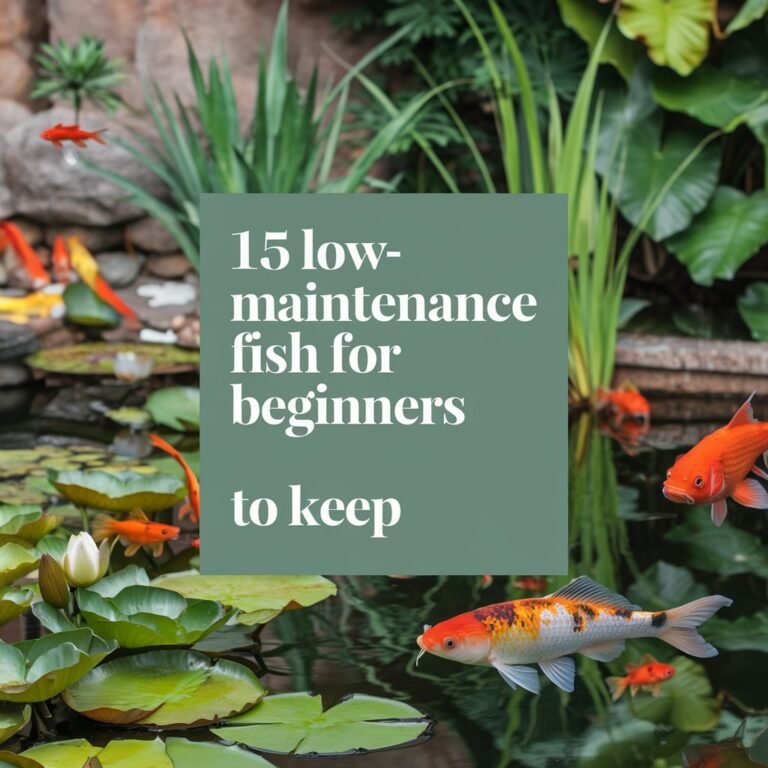15 Freshwater Fish for Beginner Aquariums to Keep
When setting up your first aquarium in 2024, you’re likely looking for freshwater fish that are easy to care for and can thrive in a beginner’s environment. You’ve probably heard of popular options like guppies and neon tetras, but there are many other fascinating species to ponder.
From peaceful community fish to solitary and low-maintenance bottom-dwellers, the choices can be overwhelming. As you explore the world of freshwater aquarium fish, you’ll want to know which species will not only survive but also flourish in your care. So, which fish should you start with?
In A Nutshell
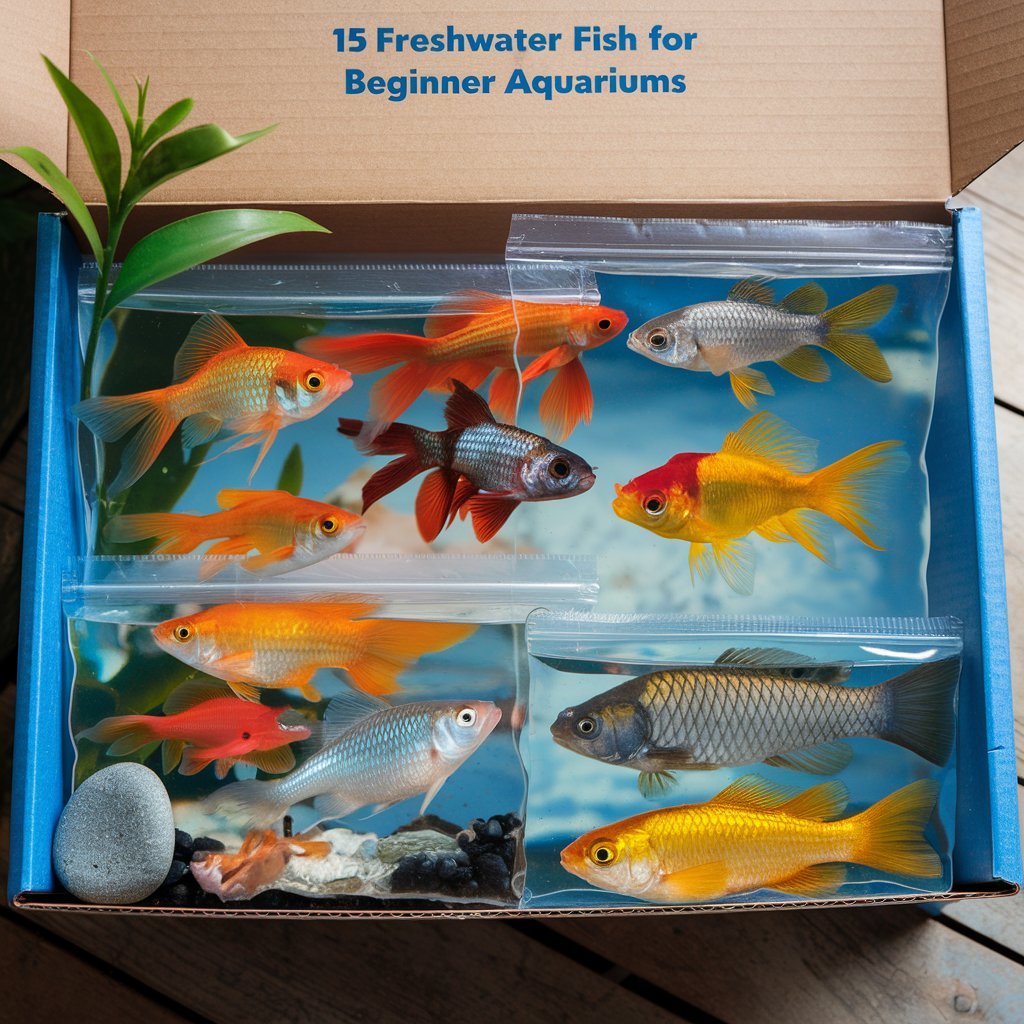
- Guppies, Neon Tetras, and Platies are popular, easy-to-care-for options for beginner aquariums.
- Peaceful community fish like Harlequin Rasboras and Lemon Tetras thrive in well-maintained tanks with open swimming areas.
- Solitary fish like Betta Fish and Dwarf Gouramis require separate territories and suitable environments.
- Bottom-dwellers like Corydoras Catfish are excellent additions, being peaceful and low-maintenance.
- Hardy fish like Zebra Danios and Swordtails are great choices for beginners due to their adaptability and ease of care.
Guppies
Guppies are a popular freshwater fish for beginner aquariums, and for good reason – they’re easy to care for and breed.
When it comes to Guppy behavior patterns, you’ll notice they’re active swimmers that thrive in schools.
They’re naturally curious and can be seen exploring their surroundings, especially when introduced to new tank decorations or plants.
As a beginner, it’s crucial to select the right Guppy tank mates to guarantee a harmonious aquarium environment.
Guppies are generally peaceful and can be paired with other calm species, such as Corydoras catfish or Harlequin rasboras.
However, it’s best to avoid keeping them with fin-nippers or aggressive fish that may harass them.
When selecting tank mates, consider their compatibility and similar water requirements.
When housing Guppies, aim for a tank with plenty of hiding places and visual barriers to reduce stress.
A well-planted aquarium with open swimming areas will help to promote their natural behavior patterns.
By understanding Guppy behavior and choosing compatible tank mates, you’ll create a thriving and enjoyable aquarium environment for both you and your fish.
This will help you feel more connected to your aquarium and the aquatic life within it.
Neon Tetras
When it comes to stocking a beginner’s aquarium with small, peaceful fish, Neon Tetras often top the list.
These tiny, iridescent fish are easy to care for and add a pop of color to your tank.
To keep Neon Tetras happy and healthy, follow these care tips: maintain a temperature range of 68-78°F (20-25°C), pH levels between 6.0-7.0, and water hardness of 1-10 dGH.
Provide plenty of hiding places and plants, as Neon Tetras are skittish and prefer to school together.
In terms of breeding, Neon Tetras are relatively challenging to breed in captivity.
To increase your chances of success, create a separate breeding tank with slightly acidic water (pH 6.0-6.5) and a temperature range of 72-82°F (22-28°C).
Use a sponge filter and add plenty of plants, such as Java moss or Anacharis, to provide hiding places for the eggs.
When breeding Neon Tetras, it’s crucial to simulate the natural conditions of their native habitat.
Goldfish
How well-suited are Goldfish for your beginner aquarium? They can thrive in your aquarium if you provide them with the right environment.
Goldfish are cold-water fish and prefer cooler temperatures between 65-75°F (18-24°C). They also require plenty of space to swim, making a goldfish tank size of at least 20 gallons per fish vital.
When it comes to Goldfish care tips, maintaining good water quality is imperative. Goldfish produce a lot of waste, so regular water changes (about 10-15% every week) are pivotal.
You’ll also need to provide a balanced diet that includes a mix of commercial flakes, pellets, and live or frozen foods. Avoid overfeeding, as this can lead to digestive issues.
Goldfish are social animals and can be kept in small schools, but they can also be aggressive towards each other. Introduce them slowly and under close observation to guarantee harmony.
With proper care and attention, Goldfish can live for 10-15 years or more, making them a long-term companion for your aquarium. By following these Goldfish care tips, you can create a happy and healthy environment for your fish to thrive.
Betta Fish
After considering the long-term commitment required to care for Goldfish, you might be looking for a low-maintenance alternative for your beginner aquarium.
Betta fish are a popular choice, and for good reason. They’re relatively easy to care for and can thrive in smaller spaces, making them ideal for small aquariums or those with limited space.
Betta fish behaviors are largely solitary, and they prefer to have their own territory. As a result, it’s best to keep them alone in their aquarium.
They’re also known to be territorial, so you’ll want to guarantee their habitat is designed to meet their needs. Betta fish habitats should include plenty of hiding places, plants, and open swimming space. A well-planted aquarium with a temperature range of 76-82°F (24-28°C) and pH between 6.5-7.5 is ideal.
In terms of care, betta fish are relatively low-maintenance. They’re not picky eaters and can thrive on a diet of commercial pellets or flakes.
Regular water changes and proper filtration will also help keep your betta fish healthy and happy. With proper care, betta fish can live for up to 3-5 years, making them a great choice for beginners.
Zebra Danios
You may be surprised to learn that Zebra Danios are an excellent choice for beginner aquariums, given their hardy nature and ability to thrive in a variety of conditions.
These active, schooling fish are easy to care for and can tolerate changes in water temperature and chemistry. Zebra Danios are a good choice for community aquariums, as they’re generally peaceful and can be kept with other non-aggressive fish.
In terms of zebra danio care, you’ll want to provide them with plenty of open swimming space and plants for shelter.
They prefer soft, slightly acidic water with temperatures between 65-77°F (18-25°C). Zebra Danios are also prolific breeders, and breeding them can be a fun and rewarding experience.
For successful zebra danio breeding, you’ll want to set up a separate breeding tank with a sand or bare bottom and plenty of hiding places. Zebra Danios will spawn in the morning, and the eggs will hatch within 2-3 days.
Corydoras Catfish
Corydoras Catfish, also known as Cory Cats, make excellent additions to beginner aquariums due to their small size, peaceful nature, and ability to thrive in a variety of water conditions.
They’re relatively low-maintenance fish that can tolerate minor fluctuations in water parameters, making them perfect for those new to aquarium-keeping.
You’ll find that Corydoras Catfish are primarily bottom-dwellers, spending most of their time scavenging for food on the substrate.
They’re social creatures and prefer to be kept in small schools, so consider keeping at least six individuals together.
Corydoras behavior is generally calm and peaceful, but they can be skittish at times, especially when first introduced to a new environment.
In terms of Corydoras habitat, they prefer soft to moderately hard water with a pH range of 6.5-7.5.
A temperature range of 72-82°F (22-28°C) is ideal for these fish.
You can replicate their natural habitat by adding plants, rocks, and driftwood to your aquarium.
Avoid strong water currents, as Corydoras Catfish aren’t strong swimmers.
Harlequin Rasboras
The Harlequin Rasbora, a popular choice for beginner aquariums, brings vibrant orange and blue hues to your aquatic landscape.
Native to the warm waters of Southeast Asia, this peaceful species thrives in a well-maintained tank with adequate hiding places and a varied water flow.
In the wild, Harlequin Rasboras inhabit shallow, slow-moving streams and rivers.
To replicate their natural habitat, you’ll want to create a Harlequin habitat that includes open swimming areas, dense vegetation, and a mix of sand and gravel substrate.
A temperature range of 72-82°F (22-28°C) and pH levels between 6.0-7.5 will promote peak health.
Rasbora schooling is a natural behavior for this species, so it’s crucial to keep them in a school of at least six individuals.
This won’t only reduce stress but also encourage their active, darting behavior.
With proper care, Harlequin Rasboras can live up to five years in your aquarium.
By providing the right environment and social structure, you can enjoy the beauty and energy of these stunning fish.
Regular water changes, a balanced diet, and a well-designed tank will guarantee a thriving community of Harlequin Rasboras.
Lemon Tetras
Freshwater aquariums often feature Lemon Tetras, a popular species known for their bright yellow coloration and iridescent scales.
You’ll find that these small fish are easy to care for and can thrive in a well-maintained aquarium. Lemon Tetras are schooling fish, so it’s best to keep them in groups of at least six to ten individuals.
This will help to promote their natural behavior and reduce stress.
When it comes to Lemon tetra behavior, you can expect them to be active swimmers, darting in and out of plants and decorations.
They’re also known to be curious, often exploring their surroundings and interacting with other fish.
To keep your Lemon Tetras happy and healthy, provide them with plenty of hiding places and open swimming areas.
In terms of Lemon tetra diet, these fish are omnivores and will eat a variety of foods.
You can feed them high-quality commercial flakes or pellets, as well as live or frozen foods like brine shrimp or bloodworms.
Aim to provide a balanced diet that includes a mix of protein sources and plant-based foods.
Dwarf Gouramis
Dwarf Gouramis are a popular choice for beginner aquariums due to their small size and vibrant colors.
They’re relatively easy to care for, but you’ll need to provide them with a suitable environment. For ideal dwarf gourami care, maintain a tank size of at least 10 gallons with plenty of hiding places and plants.
Keep the water temperature between 72°F and 82°F, and guarantee a pH range of 6.8 to 8.5.
When it comes to feeding, dwarf gouramis are omnivores and will thrive on a diet of high-quality commercial flakes or pellets, supplemented with live or frozen foods.
Avoid overfeeding, as this can lead to digestive issues.
If you’re interested in breeding dwarf gouramis, you’ll need to provide a separate breeding tank with a temperature range of 82°F to 86°F.
Males will build bubble nests, and females will lay eggs in these nests.
With proper care and attention, you can successfully breed dwarf gouramis and enjoy the experience of raising these beautiful fish.
Platies
You’ve likely considered the vibrant colors and lively personalities of dwarf gouramis for your beginner aquarium, but another popular choice worth exploring is platies.
Platies are a great option for beginners due to their ease of care and peaceful nature. They come in various Platy varieties, including the micrurus, maculatus, and xiphidium, offering a range of colors and fin shapes to suit your aquarium’s aesthetic.
In terms of Platy compatibility, they can thrive in community aquariums with other peaceful fish.
They’re active swimmers and prefer open spaces, so a spacious aquarium with plenty of hiding places is ideal. Platies are also prolific breeders, so it’s best to keep them in a single-sex group or a large enough group to dilute aggression.
A ratio of one male to three or four females is recommended. With proper care and attention, platies can live up to three to five years, making them a great long-term addition to your aquarium.
Their small size and hardiness also make them an excellent choice for smaller aquariums, as long as the water parameters are stable and well-maintained.
Swordtails
Several species of swordtails are well-suited for beginner aquariums, offering a mix of vibrant colors and lively personalities.
You’ll find that swordtails are generally hardy and easy to care for, thriving in well-maintained aquariums with temperatures between 72°F and 82°F.
When it comes to Swordtail colors, you can expect a range of options, including red, blue, green, and yellow, often with striking patterns and markings.
Swordtail finnage is another notable feature, with males boasting long, flowing tails that can reach up to 2 inches in length.
Females, on the other hand, have shorter, more rounded tails.
You’ll want to guarantee that your aquarium provides plenty of swimming space for these active fish, as well as plenty of hiding places and plants to reduce stress.
Swordtails are also prolific breeders, so be prepared for the possibility of fry (baby fish) if you’re keeping males and females together.
With proper care and attention, swordtails can make a wonderful addition to your beginner aquarium, providing hours of entertainment and enjoyment.
Mollies
Incorporating mollies into your beginner aquarium can be a great choice, given their relatively small size, peaceful nature, and vibrant colors.
These fish are easy to care for and can thrive in a well-maintained aquarium with proper filtration and water parameters. Mollies are livebearers, meaning they give birth to live young, and can be a great choice for beginners who want to experience breeding fish.
Molly behavior patterns are generally docile and social. They’re active swimmers and can be kept in small schools.
Vital to provide plenty of hiding places and plants to help them feel secure.
When it comes to Molly breeding techniques, imperative to maintain a separate breeding tank with a ratio of one male to two or three females.
The water temperature should be between 72-82°F, and the pH level should be between 7.5-8.5.
Mollies can breed quickly, and vital to remove the fry to a separate tank to prevent predation.
With proper care and attention, mollies can be a great addition to your beginner aquarium, providing hours of entertainment and enjoyment.
Cherry Barbs
For those looking to add some dynamic movement and color to their beginner aquarium, Cherry Barbs can be a fantastic addition, especially given their small school sizes and vibrant red hue.
They’re an excellent choice for smaller tanks, thriving in groups of six to ten. In the wild, Cherry Barbs inhabit the warm, slightly acidic waters of Sri Lanka.
When recreating a Cherry Barb habitat in your aquarium, maintain temperatures between 73-82°F and pH levels of 6.5-8.
When it comes to Cherry Barb diet, you can feed them a varied and nutritious meal.
Offer them a staple diet of high-quality flake food and supplement it with frozen or live foods, such as brine shrimp, daphnia, and bloodworms.
As they’re an omnivorous species, you should aim for a balanced diet with plenty of vegetables.
Aim for several feedings a day and provide enough space to confirm the Cherry Barbs are receiving sufficient food.
Provided the ideal habitat and diet conditions are met, your Cherry Barbs can lead active lives for two to three years or even more, provided their school receives sufficient social interaction and remains uneventful from their unique adaptations, breeding purposes aside.
White Cloud Mountain
White Cloud Mountain fish are an excellent choice for beginner aquariums, offering their striking silver scales and vibrant red fins as a beautiful addition to your tank.
Native to the mountain habitats of China, these fish thrive in cooler temperatures, typically between 64°F and 75°F (18°C and 24°C). They prefer well-oxygenated water with moderate currents, making them suitable for aquariums with adequate filtration.
When replicating their natural environment, consider using plants with delicate foliage, such as Java moss or Anacharis, to create a sense of security and comfort for your White Cloud Mountain fish.
Cloudy water isn’t a concern for these fish, as they’re adapted to the turbid waters of their mountain habitats. However, regular water changes and proper maintenance are still essential to guarantee their health and well-being.
In terms of socialization, White Cloud Mountain fish are peaceful and can be kept in small schools. They’re relatively small, reaching a maximum length of 1.5 inches (3.8 cm), making them an excellent choice for smaller aquariums.
With proper care and attention, these fish can thrive in your tank, providing a stunning display of color and movement.
Honey Gouramis
A single Honey Gourami can make a stunning addition to your beginner aquarium, offering its striking yellow and orange hues.
As a beginner, you’ll appreciate their relatively small size, typically growing up to 2-3 inches in length. Honey Gouramis are native to the slow-moving waters of India and Bangladesh, so they thrive in calm aquatic habitats with plenty of hiding places.
When setting up your aquarium, consider a tank size of at least 10 gallons to provide ample space for your Honey Gourami to swim.
Maintain a temperature range of 72-82°F (22-28°C) and pH levels between 6.5-8.5. To guarantee proper fin care, avoid overcrowding and provide plenty of plants to reduce aggression and stress.
Honey Gouramis are omnivores and will eat a variety of foods, including flakes, pellets, and live or frozen foods.
Feed them 2-3 times a day, only as much as they can consume within a few minutes. With proper care and attention, your Honey Gourami can live up to 5-7 years, making them a great choice for beginners looking to build a long-term aquatic community.
Frequently Asked Questions
Can I Keep Cold-Water Fish With Tropical Fish?
You’re considering mixing cold-water fish with tropical fish, but it’s generally not recommended as tank mates due to differing temperature requirements, which can stress or even kill one or both species if not managed carefully.
How Often Should I Change Aquarium Water?
You’ll want to change aquarium water regularly, but how often depends on water testing results. Aim for 10-20% changes every 1-2 weeks as part of routine aquarium maintenance to keep your tank healthy and thriving.
What Is the Ideal Aquarium Size for Beginners?
You’ll want an aquarium size that fits your space and accommodates your chosen fish’s compatibility needs. Opt for a longer tank rather than a tall one, as it promotes stable water conditions and provides more swimming room.
Can I Mix Different Types of Freshwater Fish?
You’re considering mixing different fish types. To do this, research fish compatibility and consider their schooling behavior. Verify you choose species with similar needs, temperaments, and tank requirements to create a harmonious aquatic community.
How Long Does It Take for Fish to Adjust to Aquarium?
When introducing fish to their new environment, you’ll notice they undergo an acclimation process. This adjustment period can take anywhere from a few hours to a few days, as they cope with environmental shock and settle in.
FInal Verdict
You’ll find that these 15 freshwater fish are perfect for beginner aquariums in 2024, offering a mix of peaceful coexistence, vibrant colors, and low-maintenance care. Guppies, neon tetras, and mollies thrive in schools, while solitary fish like betta fish and honey gouramis are suitable for smaller setups.
With proper care, these fish will adapt and flourish in your aquarium, providing a thriving and engaging ecosystem for you to enjoy. Research each species’ needs to guarantee compatibility and a harmonious environment.

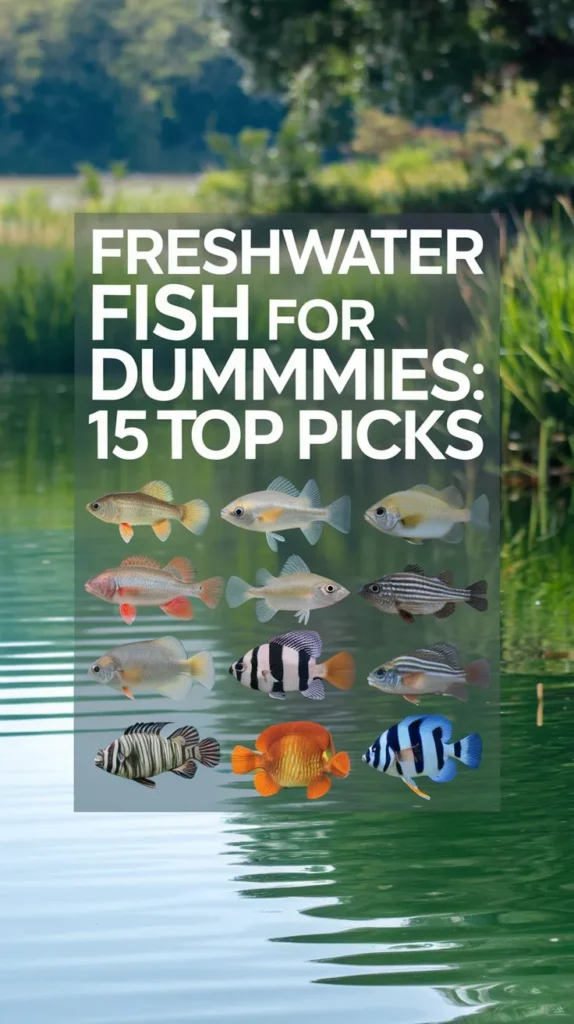
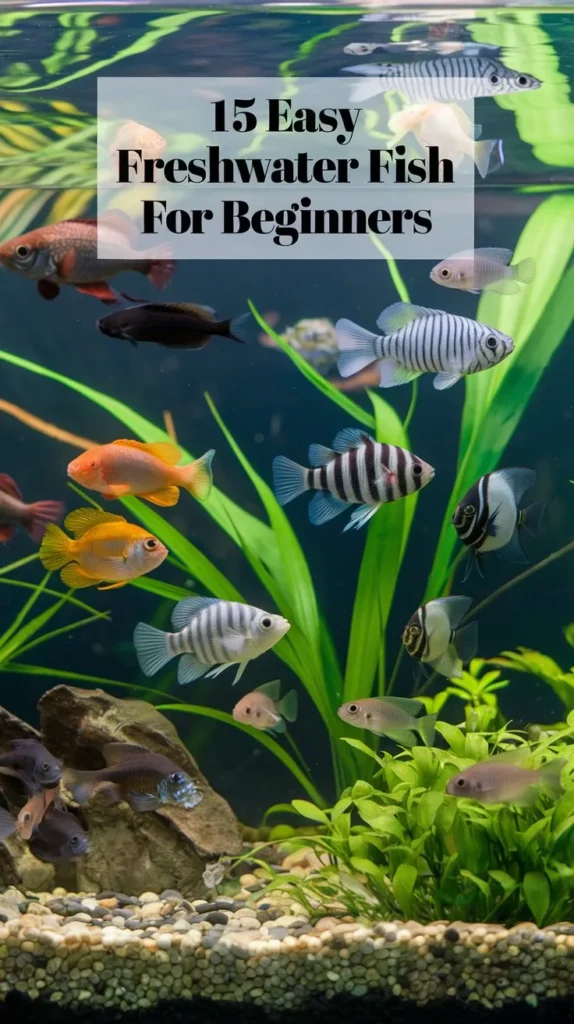
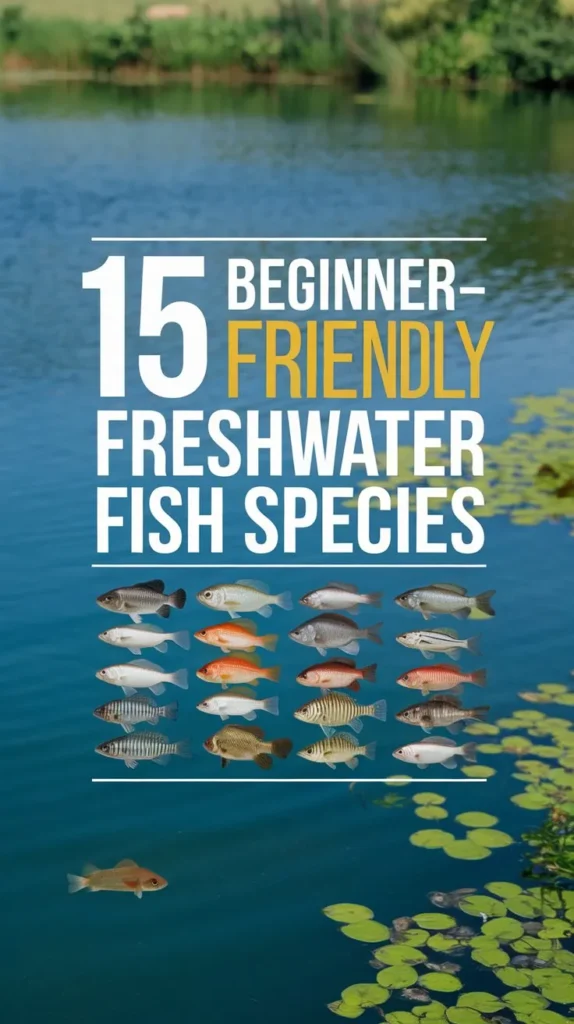
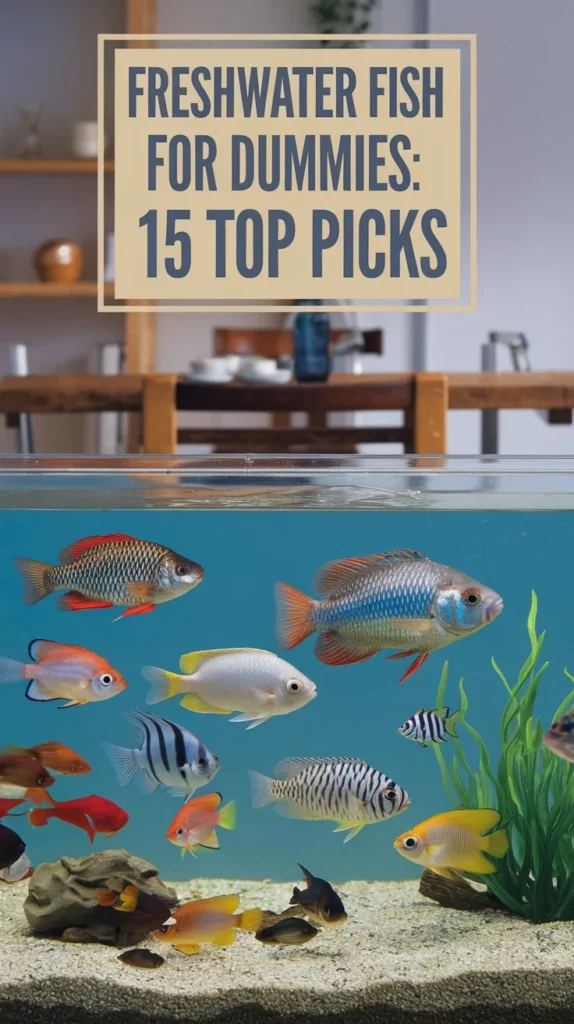
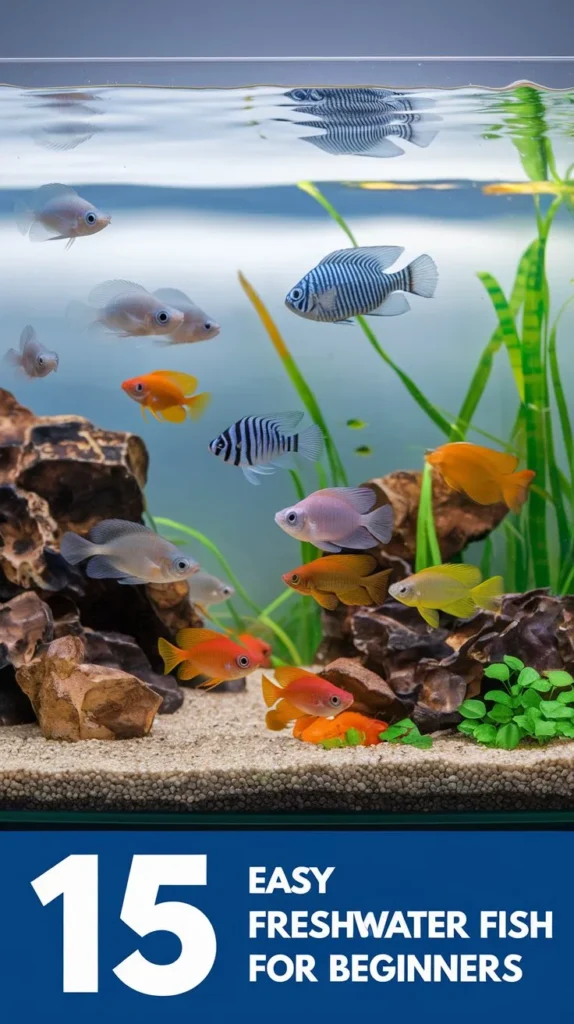
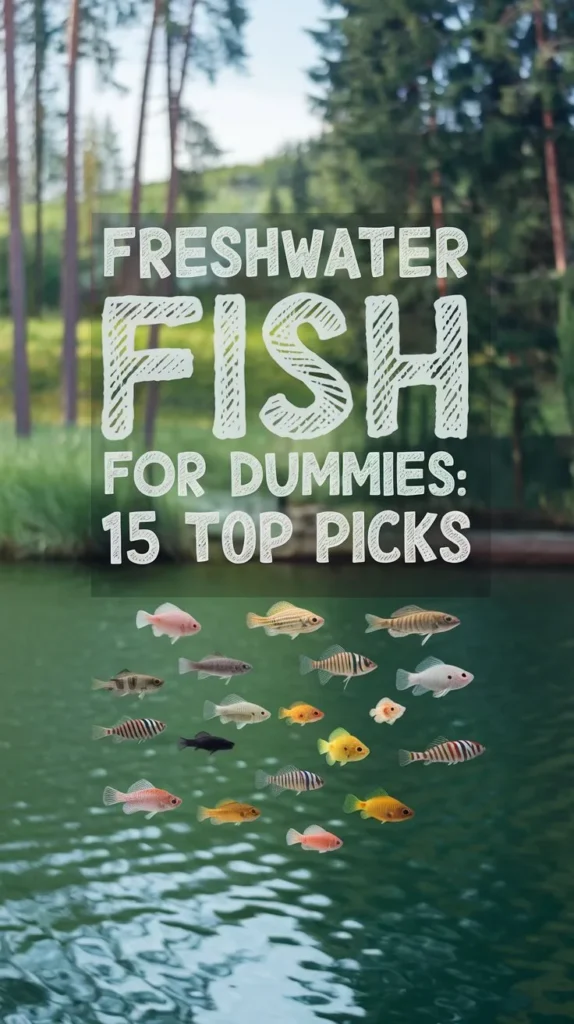
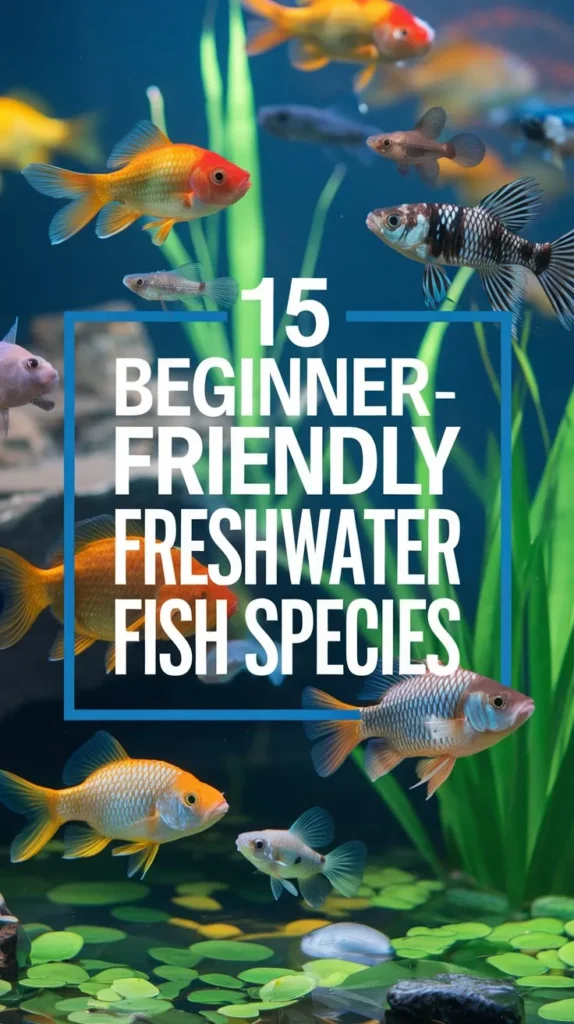
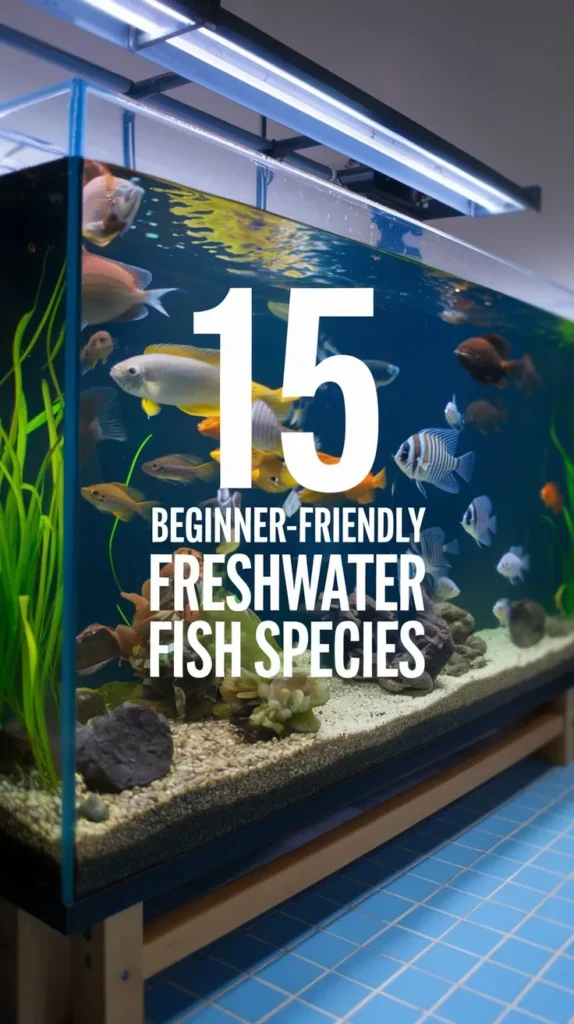
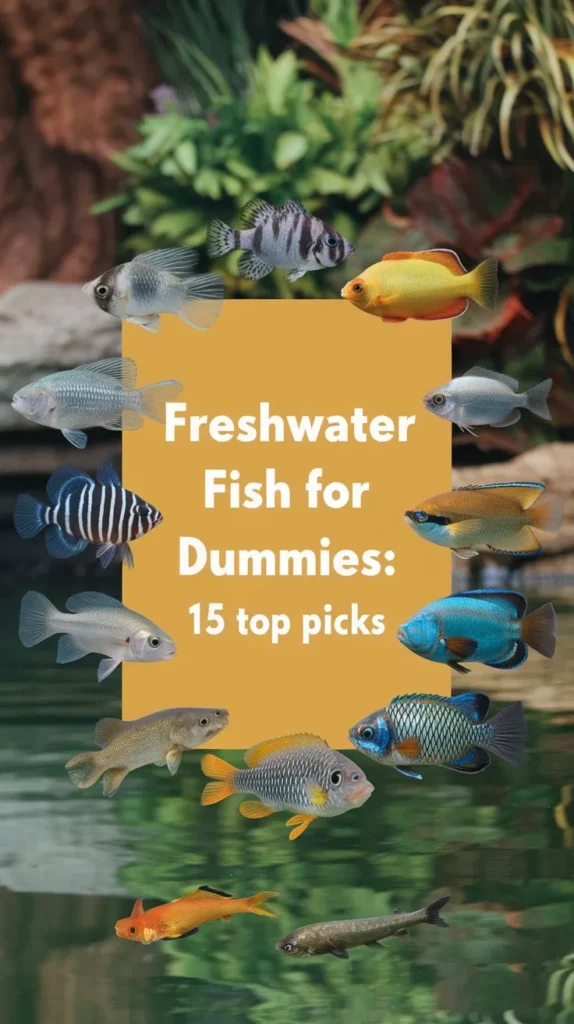

Hello, I’m Aria Cooper, the heart and soul behind Swimmy Buddies. As a devoted fish aficionado, I share my aquatic adventures and expertise to inspire your own underwater explorations. 🐠🌊

